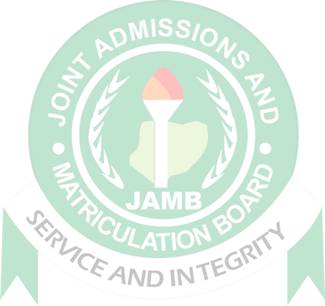
Biology
Paper 1 | Objectives | 50 Questions
JAMB Exam
Year: 1983
Level: SHS
Time:
Type: Question Paper
Answers provided
FREE
No description provided
Feedbacks
This paper is yet to be rated

Paper 1 | Objectives | 50 Questions
JAMB Exam
Year: 1983
Level: SHS
Time:
Type: Question Paper
Answers provided
No description provided
This paper is yet to be rated
Tips to make the best study space and quality time for studies are essential.
Adequate preparation and effective revision strategies tips to get a high score 320 in JAMB in 2022
12 Most Effective Ways to Pass Any Exams Without Studying Hard even when you don't have enough time.
| # | Question | Ans |
|---|---|---|
| 1. |
Root hairs are developed from the A. root apex B. epidermis of root C. vascular bundles D. endodermis E. pericycle |
B |
| 2. |
In a dicot leaf, guard cells differ from other epidermal cells because they A. have no definite shape B. lack nuclei C. are smaller D. contain chloroplast E. lack vacuole |
D |
| 3. |
Which of the following structure is NOT found in the female agama lizard? A. Pre-anal pads B. Eardrum C. Gular fold D. Nasal scale E. Nuchal crest |
E |
| 4. |
Herbs differ from shrubs because they A. do not produce fruit B. are useful to herbalist C. do not become woody D. are only annual E. are only perennials |
C |
| 5. |
If an organic compound has its hydrogen: oxygen ratio as 2:1, it is likely to be A. a protein B. a cabohydrate C. a fat D. a fatty acid and glycerol E. an amino acid |
B |
| 6. |
Which of the following elements are necessary for the formation of chlorophyll in a plant? A. magnesium and iron B. Calcium and potassium C. Calcium and sulphur D. Potasium and sulphur E. Phosphorus and potassium |
A |
| 7. |
Which of the following statements is NOT true of mammalian erythrocytes? A. They have haemoglobin B. they appear yellow when looked at singly C. They are disc shaped D. The cell are more numerous than leucocytes E. They have nuclei at maturity |
E |
| 8. |
In woody plants, grass and water vapour are transported across the stems by the A. xylem fibres B. medullary rays C. sieve tubes D. phloem fibres E. phloem parenchyma |
A |
| 9. |
Which of the following substance is not found in urine? A. Water B. Sodium chloride C. Nitrogenous compounds D. Calcium chloride E. Nitrogenous salts |
D |
| 10. |
The kidneys of all vertebrates act as osmoregulators. This means that they A. keep the composition of the plasma constant B. regulate osmotic processes C. control the volume of blood entering the kidneys D. decrease the osmotic pressure of the blood E. increase the osmotic pressure of blood |
B |
Preview displays only 10 out of the 50 Questions